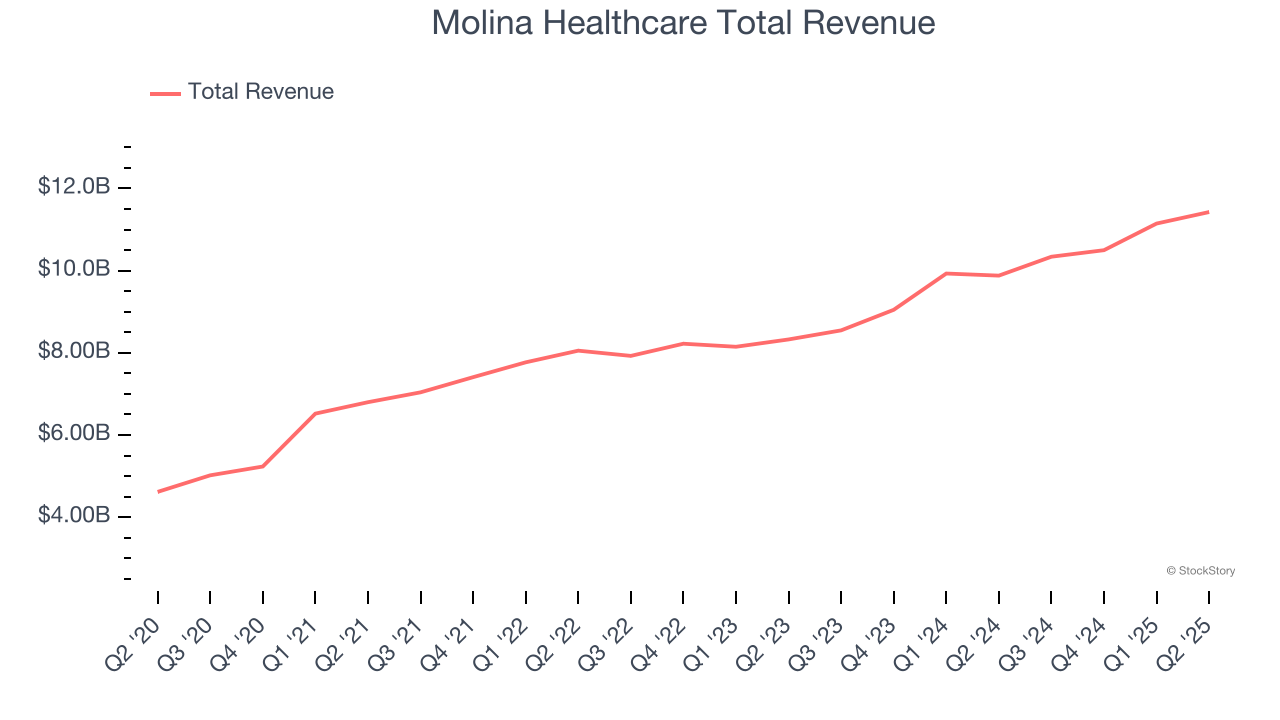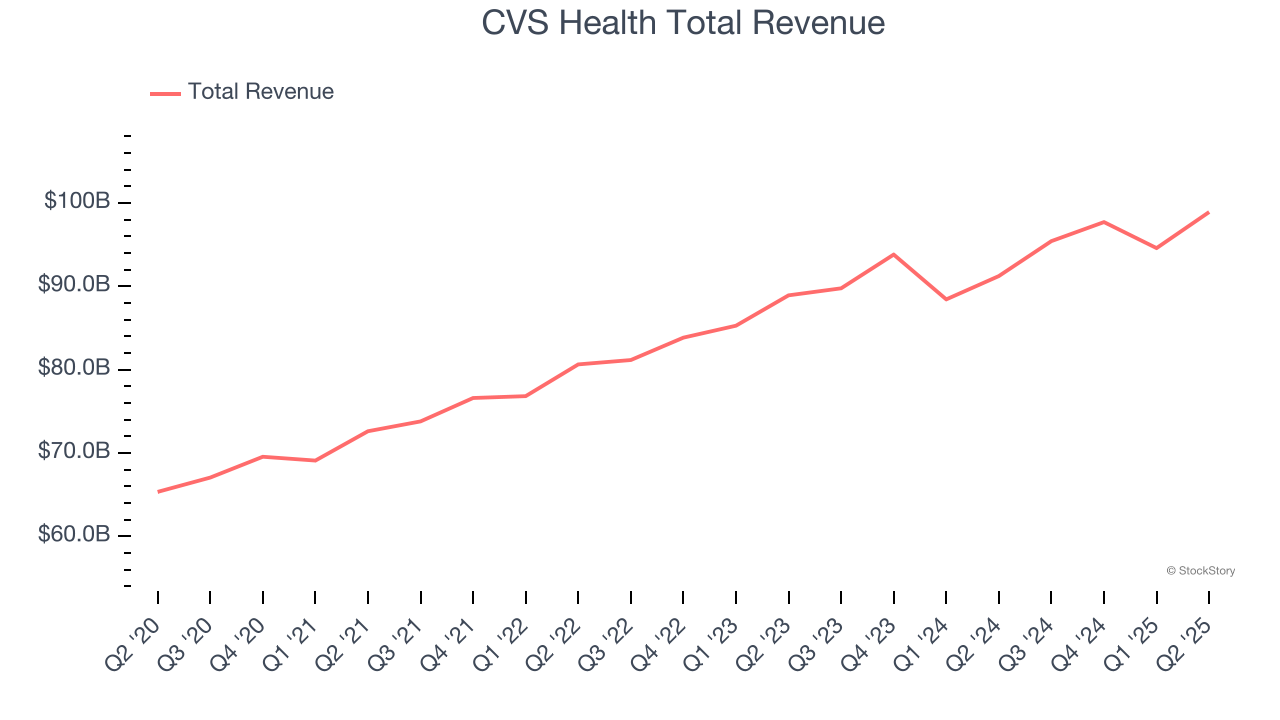
The end of an earnings season can be a great time to discover new stocks and assess how companies are handling the current business environment. Let’s take a look at how Molina Healthcare (NYSE: MOH) and the rest of the health insurance providers stocks fared in Q2.
Upfront premiums collected by health insurers lead to reliable revenue, but profitability ultimately depends on accurate risk assessments and the ability to control medical costs. Health insurers are also highly sensitive to regulatory changes and economic conditions such as unemployment. Going forward, the industry faces tailwinds from an aging population, increasing demand for personalized healthcare services, and advancements in data analytics to improve cost management. However, continued regulatory scrutiny on pricing practices, the potential for government-led reforms such as expanded public healthcare options, and inflation in medical costs could add volatility to margins. One big debate among investors is the long-term impact of AI and whether it will help underwriting, fraud detection, and claims processing or whether it may wade into ethical grey areas like reinforcing biases and widening disparities in medical care.
The 12 health insurance providers stocks we track reported a satisfactory Q2. As a group, revenues beat analysts’ consensus estimates by 3.5% while next quarter’s revenue guidance was 0.6% below.
Thankfully, share prices of the companies have been resilient as they are up 5.9% on average since the latest earnings results.
Molina Healthcare (NYSE: MOH)
Founded in 1980 as a provider for underserved communities in Southern California, Molina Healthcare (NYSE: MOH) provides managed healthcare services primarily to low-income individuals through Medicaid, Medicare, and Marketplace insurance programs across 21 states.
Molina Healthcare reported revenues of $11.43 billion, up 15.7% year on year. This print exceeded analysts’ expectations by 4.4%. Despite the top-line beat, it was still a slower quarter for the company with a significant miss of analysts’ full-year EPS guidance estimates and a slight miss of analysts’ customer base estimates.
“Our second quarter results and revised full year outlook reflect a challenging medical cost trend environment,” said Joseph Zubretsky, President and Chief Executive Officer. “The current earnings pressure we are experiencing results from what we believe to be a temporary dislocation between premium rates and medical cost trend which has recently accelerated. We are still performing near our long-term target ranges, and nothing has changed our outlook for the long-term performance of the business.”

Molina Healthcare delivered the weakest full-year guidance update of the whole group. The company lost 6,000 customers and ended up with a total of 5.75 million. Unsurprisingly, the stock is down 10.7% since reporting and currently trades at $170.30.
Is now the time to buy Molina Healthcare? Access our full analysis of the earnings results here, it’s free.
Best Q2: CVS Health (NYSE: CVS)
With over 9,000 retail pharmacy locations serving as neighborhood health destinations across America, CVS Health (NYSE: CVS) operates retail pharmacies, provides pharmacy benefit management services, and offers health insurance through its Aetna subsidiary.
CVS Health reported revenues of $98.92 billion, up 8.4% year on year, outperforming analysts’ expectations by 5.1%. The business had a stunning quarter with an impressive beat of analysts’ same-store sales estimates and a beat of analysts’ EPS estimates.

The market seems happy with the results as the stock is up 12.5% since reporting. It currently trades at $70.10.
Is now the time to buy CVS Health? Access our full analysis of the earnings results here, it’s free.
Oscar Health (NYSE: OSCR)
Founded in 2012 to simplify the notoriously complex American healthcare system, Oscar Health (NYSE: OSCR) is a technology-focused health insurance company that offers individual and small group health plans through its cloud-native platform.
Oscar Health reported revenues of $2.86 billion, up 29% year on year, falling short of analysts’ expectations by 3.5%. It was a disappointing quarter as it posted a significant miss of analysts’ EPS estimates.
Oscar Health delivered the weakest performance against analyst estimates in the group. Interestingly, the stock is up 21.9% since the results and currently trades at $16.85.
Read our full analysis of Oscar Health’s results here.
Progyny (NASDAQ: PGNY)
Pioneering a data-driven approach to family building that has achieved an industry-leading patient satisfaction score of +80, Progyny (NASDAQ: PGNY) provides comprehensive fertility and family building benefits solutions to employers, helping employees access quality fertility treatments and support services.
Progyny reported revenues of $332.9 million, up 9.5% year on year. This print topped analysts’ expectations by 3.9%. Overall, it was an exceptional quarter as it also logged an impressive beat of analysts’ sales volume estimates and EBITDA guidance for next quarter exceeding analysts’ expectations.
The stock is up 5.3% since reporting and currently trades at $24.25.
Read our full, actionable report on Progyny here, it’s free.
Alignment Healthcare (NASDAQ: ALHC)
Founded in 2013 with a mission to transform healthcare for seniors, Alignment Healthcare (NASDAQ: ALHC) provides Medicare Advantage health plans for seniors with features like concierge services, transportation benefits, and technology-driven care coordination.
Alignment Healthcare reported revenues of $1.02 billion, up 49% year on year. This number beat analysts’ expectations by 5.7%. It was a very strong quarter as it also produced a beat of analysts’ EPS estimates and full-year EBITDA guidance exceeding analysts’ expectations.
Alignment Healthcare achieved the fastest revenue growth and highest full-year guidance raise among its peers. The company added 6,200 customers to reach a total of 223,700. The stock is up 18.8% since reporting and currently trades at $15.50.
Read our full, actionable report on Alignment Healthcare here, it’s free.
Market Update
The Fed’s interest rate hikes throughout 2022 and 2023 have successfully cooled post-pandemic inflation, bringing it closer to the 2% target. Inflationary pressures have eased without tipping the economy into a recession, suggesting a soft landing. This stability, paired with recent rate cuts (0.5% in September 2024 and 0.25% in November 2024), fueled a strong year for the stock market in 2024. The markets surged further after Donald Trump’s presidential victory in November, with major indices reaching record highs in the days following the election. Still, questions remain about the direction of economic policy, as potential tariffs and corporate tax changes add uncertainty for 2025.
Want to invest in winners with rock-solid fundamentals? Check out our Top 6 Stocks and add them to your watchlist. These companies are poised for growth regardless of the political or macroeconomic climate.
StockStory is growing and hiring equity analyst and marketing roles. Are you a 0 to 1 builder passionate about the markets and AI? See the open roles here.





